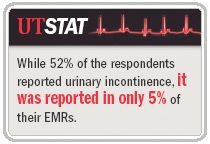Article
Incontinence survey data differ from medical records
Atlanta-Undiagnosed urinary incontinence may occur in up to half of adult women age 25 to 80 years, according to a survey sent to patients at Kaiser Permanente Northwest Health Maintenance Organization, Portland, OR.
Atlanta-Undiagnosed urinary incontinence may occur in up to half of adult women age 25 to 80 years, according to a survey sent to patients at Kaiser Permanente Northwest Health Maintenance Organization, Portland, OR.

The study results were presented at the AUA annual meeting by Dr. Clemens and Sima Patel, a medical student at Northwestern.

SUI most common
Fifty percent of women reported they had experienced some type of urinary incontinence within the past week. Stress urinary incontinence was the most common complaint, accounting for 34% of the cases, while 23% reported mixed urinary incontinence, 15% had urge incontinence, and 28% reported other forms of incontinence.
The Sandvik severity index was used to determine incontinence severity (mild, moderate, severe, very severe). The index is a composite of patient self-reported frequency (once a month, a few times per week, or daily); quantity (drops, small splashes, and more); and quality of life (ranging from dissatisfied to mostly satisfied). Patients were also asked whether they wet their clothes and used sanitary napkins. Among the women who reported urinary incontinence or urinary leakage, 53.6% were classified as moderate, 34.5% as mild, 9.8% as severe, and 2.1% as very severe. Questionnaires from those with at least moderate incontinence indicated a significant impact of the incontinence on their quality of life.
Incontinence is unrecognized
Investigators conducted reviews of the electronic medical records of all 234 women who reported moderate to very severe incontinence (Sandvik scores 3-12). All provider contacts (telephone calls, office visits) for the year preceding the questionnaire were reviewed. This was done to determine if the incontinence was truly undiagnosed or if it had been diagnosed but not recorded as an ICD-9 code in the medical record. The average number of contacts during this prior time was 5.1 (range, 0-19). They found that urinary incontinence was only documented as a symptom in 5% of patients.
They concluded that the majority of undiagnosed incontinence was truly unrecognized rather than uncoded, and that most unrecognized incontinence is not clinically insignificant.

















